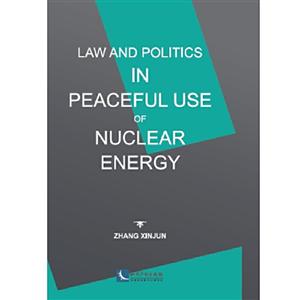掃一掃
關注中圖網
官方微博
本類五星書更多>
-
>
法律的悖論(簽章版)
-
>
中華人民共和國憲法
-
>
中華人民共和國勞動法
-
>
私人財富保護、傳承與工具
-
>
再審洞穴奇案
-
>
法醫追兇:破譯犯罪現場的156個冷知識
-
>
法醫追兇:偵破罪案的214個冷知識
和平利用核能:核不擴散的法和政治 版權信息
- ISBN:9787513067539
- 條形碼:9787513067539 ; 978-7-5130-6753-9
- 裝幀:平裝-膠訂
- 冊數:暫無
- 重量:暫無
- 所屬分類:>>
和平利用核能:核不擴散的法和政治 本書特色
本書以《核不擴散公約》(NPT的解釋批判理論為基礎,重新審視核不擴散法中和平利用核能中規定的“不可剝奪之權利”。揭示規則導向的法律思維在條約解釋中的謬誤。借鑒了建構主義本體論的觀點,即規范和制度是主體間構建的結果。這種視角有助于為把法律理解為過程提供理論基礎。上述理論有助于真正闡釋和構建和平利用核能的 “不可剝奪的權利” 和多邊核出口管制之間的法律關系。
和平利用核能:核不擴散的法和政治 內容簡介
本書以《核不擴散公約》(NPT的解釋批判理論為基礎,重新審視核不擴散法中和平利用核能中規定的“不可剝奪之權利”。揭示規則導向的法律思維在條約解釋中的謬誤。借鑒了建構主義本體論的觀點,即規范和制度是主體間構建的結果。這種視角有助于為把法律理解為過程提供理論基礎。上述理論有助于真正闡釋和構建和平利用核能的 “不可剝奪的權利” 和多邊核出口管制之間的法律關系。
和平利用核能:核不擴散的法和政治 目錄
Preface
1 "Inalienable Right" to Peaceful Use of Nuclear Energy and the Changing Nuclear Nonproliferation Regime
1.1. Introduction
1.2. The Changing World: International Regulations on Sensitive Nuclear Activities/Technologies and Nuclear Exports
1.3. The Controversy over the Role of the NPT
1.4. Oudine of This Study
2 Historical Survey of the Pre-NPT Nuclear Nonproliferation Regime: The Emergence of Dynamic Obligations
2.1. Introduction
2.2. The Sources of Dynamic Obligation: An Explanatory Framework
2.2.1. Uncertainty
2.2.2. The Forms of Dynamic Obligations and the Utility in the Security Issue Area
2.2.3. Normative Factors in Designing Dynamic Obligations
2.3. The Emergence of Dynamic Obligations in the Pre-NPT Nuclear Nonproliferation Regime
2.3.1. Strict Technology Denial: "Genuine Uncertainty" ?
2.3.2. From Technology Denial to Atoms for Peace: Uncertainty and Ambiguity
2.3.3. Normative Factors and the Concept of Peaceful Use of Nuclear Energy: Cases of Japan and Germany
2.4. Conclusion
3 The Making of Dynamic Obligations: the "Inalienable Right" and travaux preparatoires of NPT
3.1. Introduction
3.2. The Right to Nuclear Weapons and the Right to Peaceful Use of Nuclear Energy: The Irish Proposals for a Shared Expectation
3.3. From Expectation to Substantive Provisions: Drafting the Ambiguity
3.3.1. Incorporating the Inalienable Right in NPT drafts
3.3.2. Article IV in the Final Draft Artide
3.4. Deliberation by States: Efforts for Clarification vs. Insistence on Ambiguity
3.4.1. Clarifying the "inalienable Right".
3.4.2. On the "Right to Participate".
3.5. Conclusion
4 The Afterlife of"Inalienable Right': Emergence of a New Regulatory Scheme in the Peaceful Use of Nuclear Energy
4.1. Introduction
4.2. IAEA and Peaceful Use of Nuclear Energy
4.3. Unilateralism in Regulating Sensitive Nuclear Activities/Technology
4.3.1. The U.S. New Nonproliferation Policy on Sensitive Nuclear Activities/Technology
4.3.2. The New Policy and the Right of Prior Consent: The Case of U.S.-Japan Nuclear Energy Cooperation
4.3.3. Policy Coordination and the London Guidelines: Adjusting Trans-Adantic Relations
4.4. Multilateralism Back and Forth
4. 4.1. INFCE and the NSG-IAEA Cooperation
4.4.2. Reinforcing Regulation: Controls on Duel-Use and Conventional Nuclear Items
4.4.3. Response from Developing Countries of NPT Party States
4.5. Conclusion: A Double Separate and Unequal
5 Intentional Ambiguity and the Rule of Interpretation in the Autointerpretation of"Inalienable Right" in NPT Article IV
5.1. Introduction
5.2. The Issue concerning Interpretation of Article IV of the NPT
5.3. Autointerpretations on "inalienable Right" and their prima facie Reliance on Article 31 of the VCLT: The Past and the Present
5.3.1. Restrictive Interpretation of Ambiguous Text
5.3.2. Object and Purpose
5.3.3. Subsequent Practice and Review Conferences
5.4. Conclusion
6 The Riddle of Treaty Interpretation
6.1. Introduction
6.2. The General Rule of Interpretation: Limits and Theoretical Pitfalls
6.2.1. The Object--Un-interpretable?
6.2.2. The Law - Quis custodiet ipsos custodes?
6.3. Insufficiency of Rule-oriented Legal Thinking and the Problems of the Rule of Interpretation
6.3.1. Rule-oriented Legal Thinking and the Codified General Rule of Interpretation
6.3.2. Methodological Problems
6.4. The Constructivist Critical Views on Rule-Oriented Legal Thinking and Reconsideration of Treaty Interpretation
6.4.1. Constructivist's Basic Proposition
6.4.2. Methodological Perspective
6.5. Conclusion
7 Toward a Proper Understanding of Subsequent Practice in the Application of Dynamic Treaty Obligations
7.1. Introduction
7.2. The Traditional Concept of Subsequent Practice in the Law of Treaties
7.2.1. The Blurred Line between Modification and Interpretation
7.2.2. Subsequent Practice and Interpretation: Treaty-oriented and Customary Practice
7.3. Insufficiency of Rule-oriented Legal Thinking and the Problems of Subsequent Practice
7.3.1. The Constructivists' Contribution: "l-he Ontological Perspective
7.3.2. Subsequent Practice in "Interpreting" Dynamic Obligations and Legal Theories
7.3.3. A Practical Solution: Subsequent Practice and Good Faith in Treaty Interpretation
7.4. Conclusion
8 Concluding Remarks
Annex: Treaty on the Non-proliferation of Nuclear Weapons (1968)
Index
展開全部
和平利用核能:核不擴散的法和政治 作者簡介
張新軍,1967年生,日本京都大學法學博士,清華大學法學院副教授,外交部國際法咨詢委員會委員。主要研究方向為國際公法。
書友推薦
- >
煙與鏡
- >
推拿
- >
月亮與六便士
- >
伊索寓言-世界文學名著典藏-全譯本
- >
苦雨齋序跋文-周作人自編集
- >
山海經
- >
有舍有得是人生
- >
李白與唐代文化
本類暢銷

















